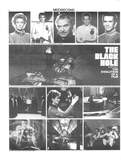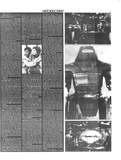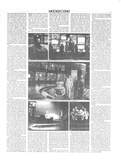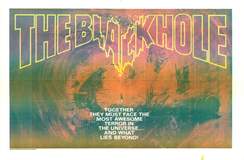Black holes may be entrances to Wonderlands. But are there Alices or white rabbits? – Carl Sagan
On December 11, 1979 Walt Disney Productions will unveil their answer to one of the greatest unsolved mysteries of astro-science when they release the $17.5 million science-fiction super-spectacle, The Black Hole. It is a breakthrough project for the Disney organization in many respects, not the least of which is a more sophisticated attitude towards the making and selling of a film that puts aside almost a half century of precedents set by the company's standard juvenile projects.
Surprisingly, there are no kids or animals in The Black Hole – they were judiciously eliminated from an early draft of the screenplay. As for the cast, they are by no means the scrubbed and saccharine family of players usually found in Disney films. Maximilian Schell, Yvette Mimieux, Anthony Perkins, Joe Bottoms, Robert Forster and Ernest Borgnine are the strongest actors ever assembled in a science-fiction film-any – where. The script, too, encompasses a share of violent drama, which may earn Disney its first PG rating but there are no plans to make any concessions to a younger market. This may even become the first film in Disney history to go out with the company logo below the title – but that particular decision is still under consideration; there's no big rush to become quite that radical yet.
The story behind the making of The Black Hole reaches back to 1974, when Disney producer Winston Hibler first sold the company on a science-fiction oriented project titled Space Station One, which featured a black hole as a minor background feature. Hibler died one year later, and Ron Miller, Disney vice-president in charge of creative affairs for TV and films, took over the project. Because of the growing public awareness and curiosity about black holes, the phenomenon was built up until it became the heart of the movie. The title, The Black Hole, followed naturally.
Star Wars undoubtedly figured in Disney‘s final decision to totally commit themselves to The Black Hole, so the studio remained resolute throughout '76 and '77, carefully planning their moves in detail. A screenplay by Jeb Rosebrook and Gerry Day, based on a story by Rosebrook, Barbara Barash and Richard Landau was accepted, and production designer/special effects wizard Peter Ellenshaw was called out of retirement to prepare the film's visual treatment. It soon became evident that this was no ordinary kids' film – the budget alone was spiralling to double that of Pete's Dragon, Disney's previous high-water mark in spending. The film would eventually take over every stage and production facility on the lot.
[…]



